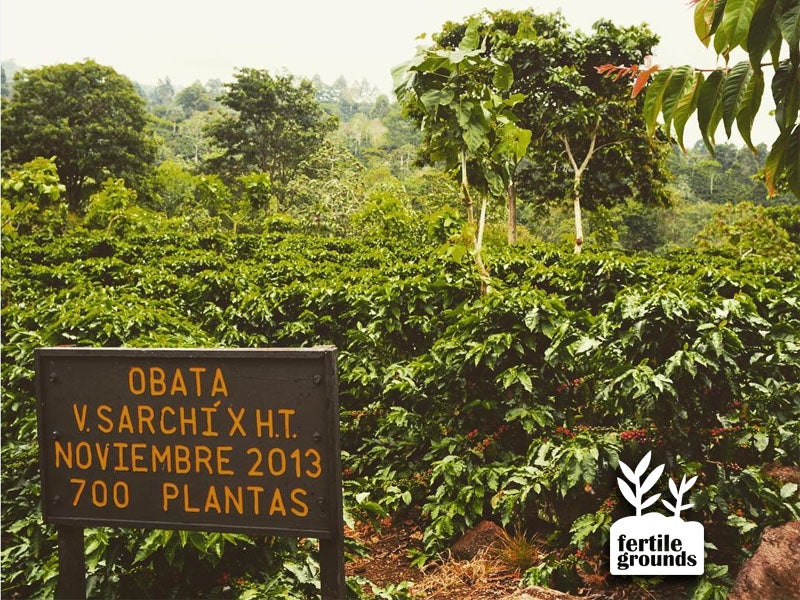Can Climate Science Save Coffee?
We need robust climate research to give farmers the tools to adapt to a changing world.

This page was published 8 years ago. Find the latest on Earthjustice’s work.
In the shade of the poró trees on the coffee farm I help run in Costa Rica, it’s not uncommon to see brightly colored birds, such as oropendolas and toucans, as well as stout, pheasant-like gallinas de monte—alongside an occasional thermometer. Mother Nature provides the wildlife; the thermometers belong to a group of scientists working with the UN’s Intergovernmental Panel on Climate Change (IPCC). The scientists are investigating whether shade trees can help coffee farmers stay in business as the Earth’s climate changes.
Coffee is a finicky plant to begin with, and climate change is making things worse. In Costa Rica, many farmers are getting out of the coffee business. Temperatures are rising, bug and fungal infestations are increasing and rainfall patterns are changing in prime coffee-growing areas. The area of land suitable for growing coffee in Central America is projected to drop 38 to 89 percent by 2050. But climate research also suggests that coffee farmers can adapt to some of these changes while reducing their own climate pollution. As we enter a warmer era, farmers need even more robust climate science to survive.
According to the data coming from our farm, Cafetalera Aquiares, shade trees are lowering the daily maximum temperature around the coffee plants by about 2 degrees Celsius. That’s great news, since temperatures in Latin America are expected to rise by about 2 degrees Celsius by 2050. In many coffee-growing regions, farmers are trying to adapt by planting at higher (and cooler) altitudes. But not everyone has enough mountainous terrain to keep chasing cooler temperatures ever higher. Shade trees could be a good option to help keep lower altitude farms in business.
Because of our shade trees, as well stream buffers, bioenergy generated from wood and plant scraps from the property and other sustainable management strategies, our Rainforest Alliance-certified farm is already a net carbon sink. But we’re always re-examining our practices. IPCC scientists are also taking a close look at how we use fertilizer on the farm. Nitrogen fertilizer has a big impact on greenhouse gas emissions, producing 5 to 10 kilograms of CO2 equivalent for every kilogram of nitrogen. Excess nitrogen fertilizer in soil can escape into the atmosphere as nitrous oxide, a potent greenhouse gas, and fertilizer can also pollute local waterways. Plus, fertilizer is expensive, and farmers—us included—don’t want to use it unnecessarily. But it’s not a straightforward process to determine how much fertilizer plants need.
Studies from around the world on crops such as rice, corn and wheat have shown that farmers can significantly cut fertilizer use without affecting crop yields. Earthjustice is working to reduce fertilizer use in the United States and globally. The organization is developing incentives for U.S. farmers to use nitrogen more efficiently and fighting in court to reduce fertilizer pollution in places like Florida’s Lake Okeechobee, where fertilizer-fueled algae outbreaks periodically cover the lake in green slime.
In Costa Rica, the scientists are monitoring a test plot on our farm to measure the effects of cutting fertilizer use in half. The results so far are encouraging. On another test plot, we’ll see how crops do when they rely largely on the natural nitrogen input from the leguminous poró tree for fertilizer.
The research being conducted on our farm provides valuable information that farmers need to stay viable as the climate changes. The IPCC group has published more than a dozen papers over the past several years, and as the results are disseminated by government agricultural agencies and NGOs, the world’s 25 million coffee farmers gain access to information that might help them make the adjustments they need to stay in business.
The notion that such research might be quashed, suppressed or defunded over the next four years—at least in the United States—as some climate scientists fear, is truly frightening. As I listened to the climate scientists summarize their work for us at the farm last month, I felt disappointment that in the coming years American farmers could be deprived of valuable information simply because the political atmosphere makes it unpopular to openly discuss the threat of climate change.
Farmers are on the front lines of climate change and will be among the hardest hit if partisan politics interferes with climate research and data gathering. Farmers must continue the vital work of growing food—and not just tasty coffee beans—no matter which political party is in power.
About this series
Fertile Grounds is a blog series that examines the challenges and opportunities in ensuring access to healthy, sustainable and affordable food for all. We talk about the entire lifecycle of food—from seed selection and planting to consumption and disposal—because there is potential for improvement throughout. We’re informed by the expertise of our many clients and allies and by Earthjustice’s years of work to ban harmful pesticides, encourage sustainable farming methods, reduce pollution, support farmworker justice and promote a healthy relationship between farmers and communities.
Earthjustice’s Sustainable Food and Farming program aims to make our nation’s food system safer and more climate friendly.